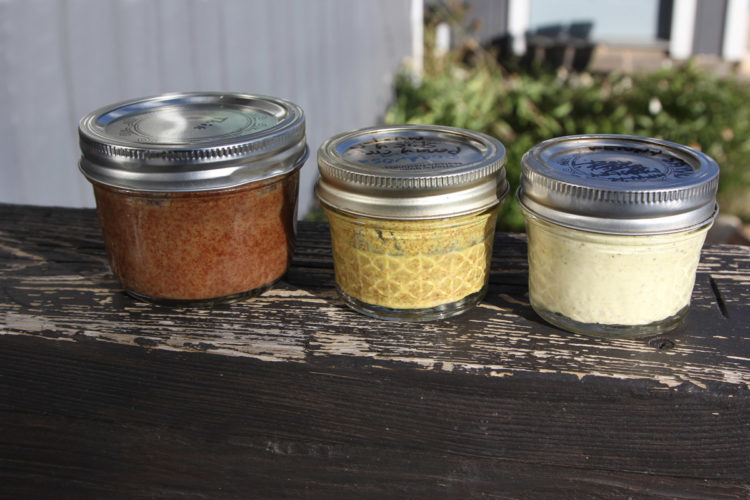
We are just back from the Midwest Wild Harvest Festival in Wisconsin, where I had the honor of presenting for the first time. One of my workshops was on wild mustards— specifically, I invited participants to join me in making three mustard condiments from the seeds of field pennycress (Thlaspi arvense).
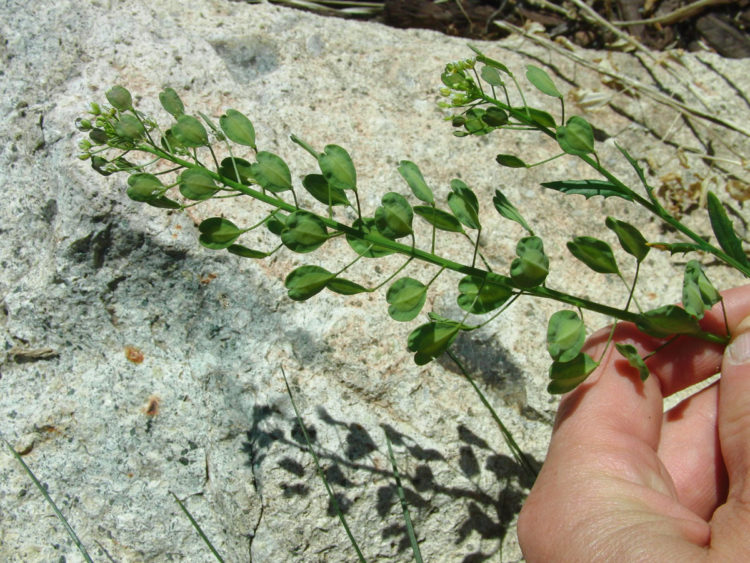
Pennycress is one of several thousand wild members of the Mustard family (Brassicaceae), which also includes cultivated veggies such as kale, cauliflower, broccoli, Brussels sprouts, cabbage, kohlrabi, collard greens and arugula. Like all mustards, it bears its flowers and later its seedpods in a structure known as a raceme, which consists of stemlets that alternate around the flower stalk like a bottle-brush or spiral staircase. Its small white flowers have four petals, four sepals, and six stamens (four long and two short), and its seedpods are penny-shaped with a small notch in each.
A non-native plant sometimes referred to as “stinkweed,” pennycress takes over farm fields in the Midwest between rotations of corn and soy, among other disturbed habitats. We didn’t spy a single specimen in the Plains states as we drove east from Colorado. Not only is the season for pennycress’ edible greens past by October in those parts, but the dry, tan-brown plants are a distant memory too. Here at 10,000 feet in Colorado’s high country, however, the season for pennycress seeds is now. You can see dry plants lining roads and parking lots in Fairplay where I live, as well as nearby Breckenridge.
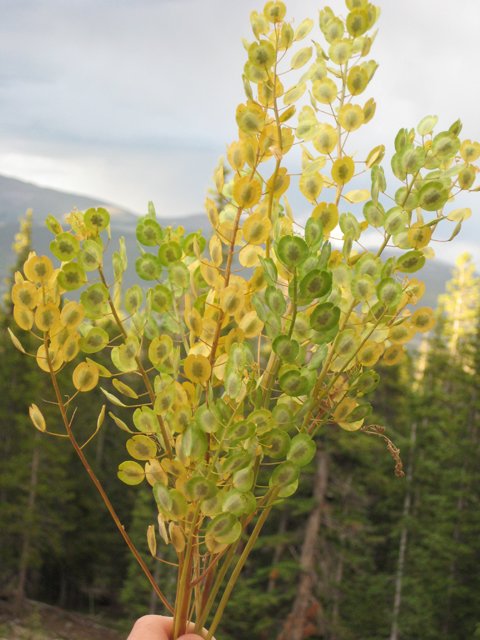
To collect pennycress seeds for mustard, look for a good stand of dry, tan-brown, brittle plants. There should be no signs of herbicide spray nearby: those sad, tortured-looking, curled, dead-and-dying plants that have become such common sights these days. If the population is clean, strip the dry seedpods into a collecting container to end up with brown, garlicky seeds and dry chaff. Then give the seeds a try to see if you like them. They won’t taste like brown mustard because they are not. They are a different mustard called pennycress. An open mind and palate are required!
After that, there are many ways to separate the seeds from chaff, but for small batches I like to swirl the lot in a bowl, tapping it to one side and carefully discarding the chaff that comes to the surface by the handful. Then I lay the rest of the material on the high end of a cookie sheet, held at a gentle slant down away from me, and carefully tap, tap, tap the tray so the seeds roll to the far end and I can spoon them off in batches. A bit of chaff in the material is fine, because you will grind up the lot to make the mustards. I discovered the hard way it is best to led these seeds air-dry, or stick them in the dehydrator at 95 degrees (F) for about three hours, or any other drying method, to make them brittle enough for a good grind that doesn’t leave chewy bits in your mouth.
As long as you got at least 1/3 cup, you are ready to endeavor one of my pennycress mustard recipes. Feel free to adjust them to your liking:
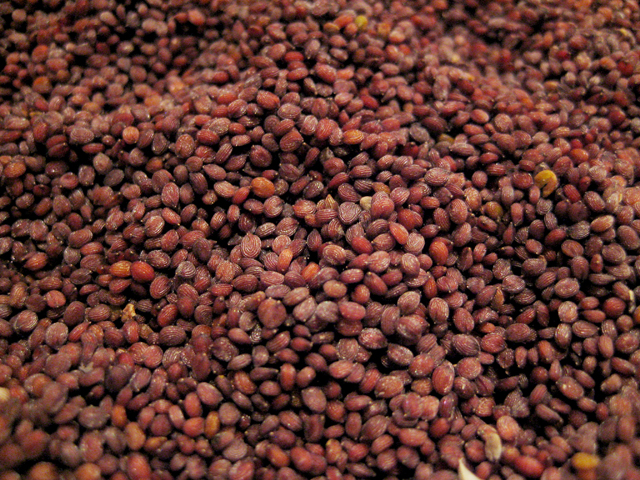
Pennycress Honey Mustard
Ingredients
- 1/3 cup dry pennycress seeds
- 5 Tbsp flour
- 2 Tbsp water
- 3 Tbsp red wine vinegar
- 5 Tbsp honey
Instructions
- Grind pennycress seeds in a spice/coffee grinder to a powder
- Mix in flour
- Add water, red wine vinegar, and honey; stir
- Eat immediately or let rest a couple days in the fridge, which is what you generally do with homemade mustards.
Note: This recipe is a slight variation on the one I posted a couple years ago. At the festival, one participant thought 4 Tbsp of honey was plenty. Another thought 5 Tbsp was not enough. Your call! Of the three recipes on this page, this one is by far my favorite. You can easily turn it into a salad dressing with the addition of lemon and more oil.
Spicy Pennycress Mustard
Ingredients
- 1/2 cup white wine vinegar
- 1/3 cup dry pennycress seeds
- 1 tsp salt
- 1/4 tsp turmeric
- 1/16 tsp allspice
- 1/8 tsp ginger
- 1/16 tsp cinnamon
- Pinch nutmeg
- Water as needed to thin
- Flour as needed to thicken
Instructions:
- Grind pennycress seeds into a powder.
- Mix ground pennycress seeds and vinegar in a small bowl and let soak at room temperature overnight.
- Mix in salt, turmeric, allspice, ginger, cinnamon, and nutmeg. Add 1 tsp of water if needed to thin consistency. If it gets too thin or you want more volume/less spiciness, mix in flour, adding water as needed.
- Taste immediately or let rest a couple days in the fridge, which is what you generally do with homemade mustards to mature the flavor.
Note: This borrows from brown mustard recipes, for which the whole seeds are often soaked overnight. When I did that with pennycress, however, the seeds refused to blend–hence the pre-grind. Also, many recipes call for white wine, not vinegar, but I wanted to make this one alcohol-free. Just a note–this mustard comes out a bit strong and bitter; if it’s too much for you, cutting it with mayonnaise and sour cream in the next recipe works like a charm.
Pennycress Sandwich Spread / Dip
Ingredients
- 1/3 cup mayonnaise
- 3 Tbsp spicy pennycress mustard (above)
- 1/2 cup sour cream
- 1⁄4 tsp garlic powder
- 1/4 tsp salt
- 1- 1½ Tbsp vinegar-soaked mustard seeds (optional)
- Pepper to taste
- Chili powder to taste (optional)
Instructions
- If you want some whole pennycress seeds in there for texture, soak a small handful overnight in white wine vinegar.
- Combine ingredients and eat as a pretzel/veggie dip, with brats, or on sandwiches.
Note: This recipe cuts the zip of the spicy mustard, making it a good choice for children.
Updated 2.24.21
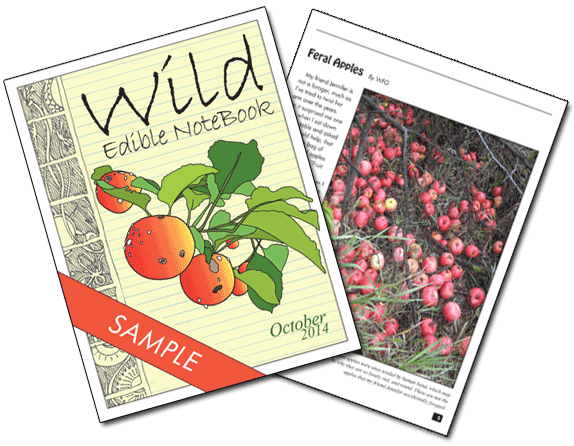
Do you have to wait for it to get dry on its own or can you pick it green and dry it yourself? I’m asking because there’s a wile field behind me with loads of it that a groundskeeper is soon going to demolish! And I can’t wait until it’s dry because it’ll be gone.
Hi Maddie, I have not had success drying green seedpods to get the seeds for mustard. Once the plants turn yellow, they are a little better. But not green ones, in my experience. You can eat the green seedpods (seeds + surrounding case), however, if they are not tough. I have heard some people pickle those. You might be able to Google a recipe. Good luck!
I have been looking at these seedpods for years and was not sure what plant they were. SO happy to know now, thank you. I look forward to trying your recipes, or at least one of them.
Hi Tammie, if you are going to pick one, my favorite by far is the honey mustard. Best of luck! Report back!
This is great, and I plan to try this in the next month or two when they ripen around here!
Have you tried any other perennial or self-seeding annual mustards? Are any close in taste to the annual mustards grown for Indian cooking?
I’d love to wow my kids with French’s Mustard style mustard, or have a local version for Indian cuisine without having to sow them annually. I’ll have to experiment with Field Pennycress, which is a pervasive weed here.
Hi Rob, I’ve tried a couple of other annual self-seeding mustards including some tansy mustards (Descurainia genus), tumble mustard (Sisymbrium altissimum) and peppergrass (Lepidium genus). Not only do these have tiny seeds that are hard to work with, their seeds are not all that pungent so they don’t make a flavorful mustard. My friend Sam Thayer describes using the seeds of black mustard (Brassica nigra) in his book, Incredible Wild Edibles, which makes a hot mustard, but I have yet to find this plant. Best of luck!
This is great